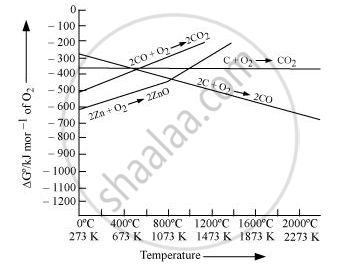Advertisements
Advertisements
प्रश्न
Out of C and CO, which is a better reducing agent for ZnO ?
उत्तर १

Reduction of ZnO to Zn is usually carried out at 1673 K. From the above figure, it can be observed that above 1073 K, the Gibbs free energy of formation of CO from C and above 1273 K, the Gibbs free energy of formation of CO2 from C is lesser than the Gibbs free energy of formation of ZnO. Therefore, C can easily reduce ZnO to Zn.
On the other hand, the Gibbs free energy of formation of CO2 from CO is always higher than the Gibbs free energy of formation of ZnO. Therefore, CO cannot reduce ZnO. Hence, C is a better reducing agent than CO for reducing ZnO.
उत्तर २
The two reduction reactions are :
`ZnO(s) + C(s) -> Zn(s) + CO(g)` ... (i)
`ZnO(s) + CO(g) -> Zn(s) + CO_2(g)` .... (ii)
In the first case, there is increase in the magnitude of ΔS° while in the second case, it almost remains the same. In other words ΔG° will have more negative value in the first case when C(s) is used as the reducing agent than in the second case when CO(g) acts as the reducing agent. Therefore, C(s) is a better reducing agent.
APPEARS IN
संबंधित प्रश्न
Out of C and CO, which is a better reducing agent at 673 K?
Giving examples, differentiate between ‘roasting’ and ‘calcination’.
Which one of the following reaction represents calcinations?
Zinc is obtained from ZnO by ____________.
Explain the following term with a suitable example.
Gangue
Explain the following term with a suitable example.
Slag
The reaction of toluene with Cl2 in presence of FeCl3 gives ‘X’ while the of toluene with Cl2 in presence of light gives ‘Y’. Thus ‘X’ and ‘Y’are ______.
At the temperature corresponding to which of the points in figure, FeO will be reduced to Fe by coupling the reaction \[\ce{2FeO -> 2Fe + O2}\] with all of the following reactions?
(a) \[\ce{C + O2 -> CO2}\]
(b) \[\ce{2C + O2 -> 2CO}\]
(c) \[\ce{2CO + O2 -> 2CO2}\]
(i) Point A
(ii) Point B
(iii) Point D
(iv) Point E
Pb and Sn are extracted from their chief are by:-
CN– solution is used in the extraction of which metal?
Colemanite is:-
Sulphide ore of the metal are usually concentrated by froth floatation process. Which of the following sulphide ore offers an exception and is concentrated by chemical leaching?
The process that involves the removal of sulphur from the ores is ______.
